Purpose
Learn how to:
- Work with Assignments, Periodic Tasks and Reminder Rule in SimplerQMS
Expected Outcome
- Users are equipped to handle Assignments, Periodic Task and Reminder Rule in SimplerQMS
Prerequisites for all
- Must be logged in to SimplerQMS
- Must be a member of one of these ‘User Groups’ to view records:
- All internal and external users
- Must be a member of one of these ‘User Groups’ to create new records
- All Contributors
Section 1: Creating an Assignment
Assignments are used to point yourself or someone else in the organization to carry out a task within the system. Assignments can be created as a standalone, not related to other records or on any record in any state. They do not need to be closed before you can proceed with the record they were created on.
Step 1.1 – Create a standalone Assignment – Initiator
There are multiple ways to create an Assignment in SimplerQMS:
I. In the Create New section, on your Home Tab, click on Assignment.

II. Click on the Create (+) next to the Home Tab and choose Assignment from the dropdown list
III. On the left side of the screen, expand Create and click on Assignment
A Metadata Card will pop up.
Step 1.2 – Fill the metadata card
Part 1: Assignment Information
| Field name | Description | Note |
| Name or Title* | A short title of the assignment | |
| Assignment Description | An optional brief description of the assignment | |
| Assigned to* | Person responsible to carry out the assignment | |
| Deadline* | A target date of completion |
When you filled all the necessary fields, click Create.
The assignee will be notified about the assignment. The assignee also gets an automatic reminder if they have not marked the assignment as completed when the deadline is approaching.
Step 1.3 – Create Assignments through Shortcut
Creating Assignments through shortcuts will automatically relate it to an object such as documents, suppliers, customers etc. In this example we will create an assignment for a document.
I. Select the document and click “Create Document Assignment” in the Task Area under Actions

II. A metadata card will pop up
III. The assignment “Name or title” will default to “Assignment: and the title of the document where it is originated from” and it will also be related to that specific document, but not limited to only that. Adding another document related to it is possible.
IV. Click create once all the necessary fields have been filled.

Step 1.4 – Complete the Assignments
To complete an assignment, the assignee will receive a notification about the assignment listed on their “Assigned to Me” section.
I. Select the Assignment and click “Mark Approved” under View and Modify on the Task Area

II. Enter your electronic signature to complete.
a. To reject or obsolete an assignment, select the assignment, and click “Mark Rejected” in the Task Area.
Any related documents which require attention can be viewed by expanding the folder structure of the assignment using the small grey arrow next to the assignment.

Section 2: Creating a Periodic Task
Periodic tasks are used for repetitive tasks. The use case of a periodic task that is created as a standalone element is to set up reminders for yourself that a template, supplier contract or other record should be reviewed on a set schedule. For documents on document types that are set to require periodic review, periodic tasks will be generated automatically. Refer to Section 3 to read more.
Step 2.1 – Create a standalone Periodic Task – Initiator
There are multiple ways to create a Periodic Task in SimplerQMS:
I. In the Create New section, on your Home Tab, click on Periodic Task.
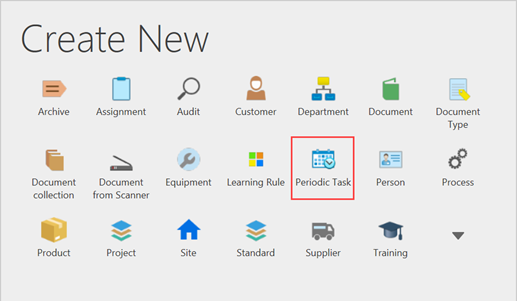
I. Click on the Create (+) next to the Home Tab and choose Periodic Task from the dropdown list
II. On the left side of the screen, expand Create and click on Periodic Task
III. A Metadata Card will pop up.
IV. Click on the drop-down arrow and you choose Periodic Task.

To learn about Reminder Rules, refer to Section 4.
Step 2.2 – Fill the metadata card
Part 1:Periodic Task Information
| Field name | Description | Note |
| Short Title* | The title of the Periodic Task | |
| Responsible Person* | The person who will get the periodic tasks assigned for evaluation once the activation date is reached. | |
| Description* | A description of the Periodic Task | |
| Relation(s) | An object from the system that is related to the Periodic Task – This will be the common denominator between the periodic tasks that are created. Once a PT has been completed, a new one gets created and tied to the same relation. | Multiple Options applicable |
| Activation Date | This field will be filled based on the Period End Date and the value set in the “Time to Complete + Activation Time Unit” fields. This is the date when the Periodic Task will be assigned to the Responsible Person for review. | |
| Period End Date | This field will be filled based on the “Period Start Date” field and the value set in the “Interval + Time Unit” fields. This is the date by which the Periodic Task will need to be finished. | |
| Interval* | The span of time between the start date and end date, which refer to the value of time unit | In case of an automatic assignment, the System Default – 2 |
| Time Unit* | Refers to the value of Interval (Year, Month, Week, or Day) | System Default – Years |
| Time to Complete* | The calculated time to complete the task. Refer to values of activation time unit | System Default – 60 |
| Activation Time Unit* | Refers to the value of time to complete (Years, Month, Week, or Day) | System Default – 60 |
| Period Start Date | Depending on this value, the Periodic task dates will be populated. |
When you have filled all the necessary fields, click Create.
If the Period Start Date is in the future, the task will automatically be set to state “Scheduled” and will be assigned to the RP when the activation date kicks into action.
Step 2.3 – Complete the Periodic Task – Responsible Person
I. Select the task
II. Click “Completed” in the Task Area
III. Sign using your electronic signature

The task is completed, and it is removed from the Assigned to Me section. The state will change to “Closed” and no further actions can be carried out.
A new periodic task will be scheduled with the same name, but a different ID. If you have set up relations to for e.g., a supplier, then you can see that the new periodic task will be tied to the same relation.

If the periodic task is free-standing and not connected to other properties, but you would like to reschedule or resolve it sooner, you can find it by navigating to the Main Views, then Tasks & Assignments, then Periodic Tasks.
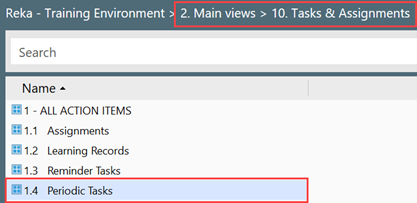
NOTE: Periodic Tasks and Periodic Document Reviews past due date (Period End Date) become Overdue. The assignment description will always point out the exact due date. 
Step 2.4 – Complete a Periodic Task ahead of schedule – Responsible Person
In the state “Scheduled”, a periodic task can be completed before its scheduled start date.
I. Navigate to the Periodic Tasks view
II. Select the periodic task you would like to complete
III. Click “Complete Task Now” under State Transition
a. This is also the way to “Disable Task” which will disable the current task and discontinue the creation of future tasks.

Option 1 – Reschedule the Periodic Task – Responsible Person
When a task is in state “Pending Completion” you can reschedule it by clicking Reschedule under state transition.

Once clicked, the Scheduling Values section of the metadata card becomes editable, and you can set new values in the fields. The values set will determine the new Period End Date and Activation Date.
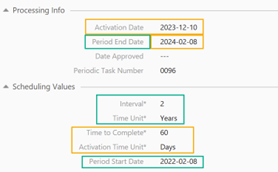
When done, click on “Scheduled” under State Transition.

NOTE: Periodic Tasks and Periodic Document Reviews can also be rescheduled on a per instance basis. If you wish to have a new schedule on the next instance, change the scheduling values in “Pending Completion” state and complete the current task.
Section 3: (Automatic) Periodic Document Review
Periodic Tasks are automatically generated on Released and Effective documents that are running on a document type that requires Periodic Review. ONLY a Metadata Administrator can create and define the Document Type properties.

Periodic Tasks that are automatically generated for document review will be running on the Class “Periodic Document Review”. To see a full list of both active and inactive document reviews, navigate to Main Views, then to Tasks & Assignments, then Periodic Document Reviews.

To find a periodic review directly related to a document, look for the document you wish to review, then expand using the small grey arrow on the left side and find the Periodic Tasks section.

The Responsible Person is assigned from the responsible person of the quality document.
The periodic task will always have a reference to the document it is initiated from so you can easily find which version needs to be reviewed.

Step 3.1 – Reschedule a Periodic Document Review – Responsible Person
On such periodic reviews, the scheduling values are system generated and are set by default to 2 years and will notify the responsible person 60 days before the period end date. The period start date is based on the date of document approval.

The state of the periodic document review will be “Scheduled” until the activation date is reached. In this state, scheduling values can be modified (e.g., if the 2 years, 60 days is too long):
I. Click on the Periodic Document Review you wish to reschedule
II. Click on “Reschedule” under State Transition
III. Reschedule will make scheduling values editable on the metadata. Change these values according to your organizations agreed values

IV. Click on “Scheduled” under State Transition to apply these values
a. A new Period End Date and Activation Date will be calculated by the system
Step 3.2 – Complete a Periodic Document Review – Responsible Person
When the activation date is reached on a periodic document review, it will go into state “Pending Completion” and will be assigned to the responsible person. The user is presented with two options. The decision between these options is based on the quality document that is tied to this periodic review.
The document can be opened directly from the periodic task in Assigned to Me:
I. Click on the Periodic Review
II. Click on the expand arrow on the left side
III. Find Versions to Review
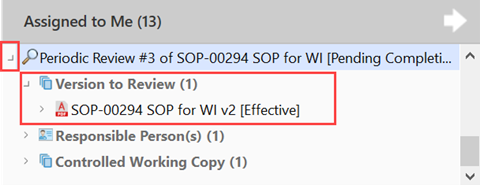
IV. Open the document and decide what action needs to be taken.
Option 1: Review Completed – No Changes Needed
If you deem that the document does not require review:
I. Click on the periodic review
II. Click on “Review Completed – No Changes Needed”
III. Enter your electronic signature

A new periodic review will be created for the same document inheriting the scheduling values of the original periodic review.

Option 2: Changes Needed (Update or Retire)
If you deem that the document needs updates or has to be retired:
I. Click on the periodic review
II. Click on “Changes Needed (Update or Retire)”

III. In state Changes Needed (Update or Retire) you can choose between sending the document for updates or retiring the document

IV. In the metadata card of the periodic review, you need to fill in the “Reason or Justification” field
a. Here you need to describe why you have made the choice to either update or retire the document

V. Click on the option that suits your need
VI. Enter your electronic signature to confirm your choice
A. On documents that run on a document type that requires a Change Request, navigate to the working copy and create a new Change Request or add the document to an existing Change Request to either update or retire.
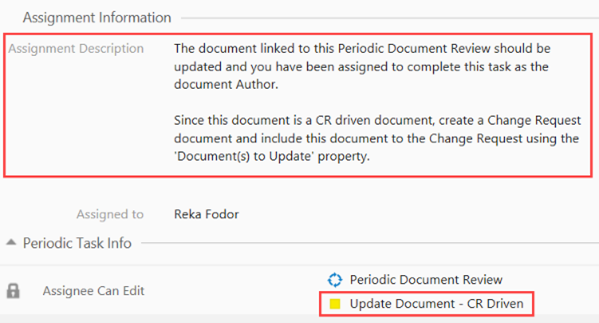
I. Refer to Work Instruction: Managing Change Request to continue.

B. On documents that do not require Change Request, the document to update will automatically be routed into a new major version for updates and get assigned to the author of the document.
Alternatively, if “Retire” is pressed it will automatically become retired.
The state of the periodic review will change based on your choice:


VII. If update is chosen in both option A or B, once the update process is done a new periodic task will be scheduled automatically, inheriting the scheduling values from the previous periodic task.
a. If the document has a future effective date, the periodic review will only be created once the document becomes effective.

VIII. If a document is retired, all previously resolved periodic reviews will become obsolete and no new periodic review will be created
Step 3.3 – Complete a Periodic Document Review ahead of schedule – Responsible Person
In the state “Scheduled”, Periodic Document Reviews can be completed ahead of the planned schedule. In the case that you would like to review a document early and end the periodic review tied to it:
I. Click on the Periodic Document Review you wish to complete
II. Click on “Review Now” under State Transition
III. Follow the instructions in Step 3.2

Section 4: Creating a Reminder Task
Reminder tasks are used strictly on the documents that are under the class Quality Document (that includes Multifile documents as well). Their intended use is to create any kind of reminder that should be tied to a document, e.g., if you update a Work Instruction in SimplerQMS that has a printed copy for use on a production floor (outside the system) and you would like to be reminded to update the printed copy when you made any updates within the system.
Step 4.1- Create a Reminder Task – Initiator
You can set up reminder tasks as early as in the “New Preliminary Document” state of a document, until the document has been approved. If you did not add a reminder to version 1 of the document, but you wished to do it, route it for an update and add a reminder to version 2.
When you create a Reminder Task you can create it through the Create options described in Section 2, except for step V, where you should choose Reminder Task as Class instead.
The recommended option is to use the document shortcut “New Reminder Task” under Actions in the Task Area of a Quality Document. To do this:
I. Select the quality document you wish to add a reminder to
II. Click on “New Reminder Task”
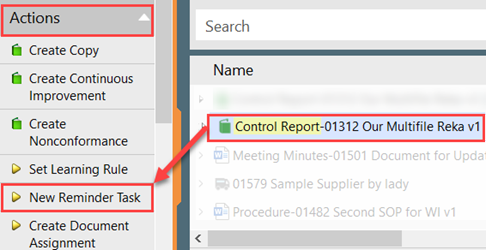
A Metadata Card will pop up.
Step 4.2 – Fill the metadata card
Part 1:Reminder Task Information
| Field name | Description | Note |
| Short Title* | The title of the Reminder Task | |
| Document to Remind* | If created through Create button: Select the document (s) that needs a reminder If added through Actions: Field is automatically set to the selected document | Please see tooltips of Reminder Task on metadata card |
| Responsible Person* | The person who will be reminded about this task | |
| Repeatable Task | By default, this box is ticked to create a recurring reminder that will be created every time the document is updated. If you wish to create a single use reminder, untick this box. | |
| Description* | Define what actions needs to be taken when this reminder is assigned to the RP | |
| Grace Period | Number of days you would allow for the completion of this reminder task. | |
| Grace Period Unit | Defined in days | |
| Due Date | The date is based on the combination of the values set as your Grace Period and the effective date of the Quality Document. |
Click Create after filling out all necessary information on the metadata card.
Step 4.3 – Verify that the Reminder Task is created – Initiator
I. Click the expand arrow on the document where you set the Reminder Task.

II. Find the Periodic Task section and click the expand arrow
III. All current and past reminders will be shown.

Step 4.4 – Complete the Reminder Task – Initiator
Once the document is released, you can complete the Reminder Task before the generated due date:
I. Select the Reminder Task, click on “Task Completed” under State Transition

II. Enter your electronic signature
III. When the task is completed, the State will change to Task Completed and the reminder is no longer assigned to the Responsible Person
NOTE: Routing a document for an update with an open reminder task is not possible. The following error message will pop up and show which reminder is currently open to be done before moving forward. This is not applicable on retiring the document. 
Step 4.5 – Retire the Reminder Task – Initiator
The reminder task can always be retired, even before the document you created it for is released.
I. Select the Reminder Task, click on “Retire Task” under State Transition

II. Retiring the reminder does not require an electronic signature
III. Retired reminders cannot be set to active again and no more actions will be available

NOTE: Retiring the related document to the reminder will not retire the reminder automatically.